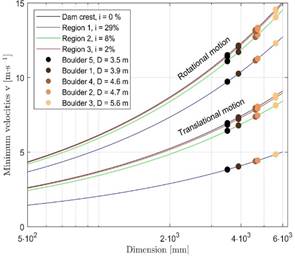Glacial lake outburst floods (floods originating from glacial lakes; GLOFs) can involve large volumes of water and so can be characterized by extreme erosion and sediment transport potential. A recent study published in the journal NHESS, explores the potential of using large GLOF-transported boulders to derive information about the hydrodynamics of a GLOF in a remote and ungauged catchment. On 12th February 2023, the complex GLOF process chain was triggered by a 1.1×106 m3 – 1.5×106 m3 landslide into lake Rasac in the Peruvian Andes. The resulting displacement wave overtopped and partly eroded the moraine dam and rushed downstream into the valley. While steeper parts of the valley directly downstream of the lake predominantly experienced erosion, flatter parts of the valley further downstream experienced deposition of transported material. The striking elements in the otherwise fine- to medium-coarse-grained deposited material are five very large boulders (each exceeding 3.5 m in diameter). High resolution optical remote sensing images revealed that these boulders must have been transported during the GLOF. Using hydrodynamics analysis, we concluded that flow velocities >5 m s?1 must have been reached in the case of translational motion and >10 m s?1 in the case of rotational motion. While direct observations of GLOF dynamics are rare, our study illustrates how flood-deposited material can help to reveal basic information about flood hydrodynamics and magnitude.

Figure: The relationship between the dimensions of deposited boulders and the minimum flow velocity required to move them (author: Jan Hrebrina).
Reference: Emmer, A., Vilca, O., Salazar Checa, C., Li, S., Cook, S., Pummer, E., Hrebrina, J., and Haeberli, W.: Causes, consequences and implications of the 2023 landslide-induced Lake Rasac glacial lake outburst flood (GLOF), Cordillera Huayhuash, Peru, Nat. Hazards Earth Syst. Sci., 25, 1207–1228, https://doi.org/10.5194/nhess-25-1207-2025, 2025.
Adam Emmer (Uni Graz, Austria; ISI Priority 3 Thematic Coordinator)
Jan Hrebrina (NTNU, Norway)